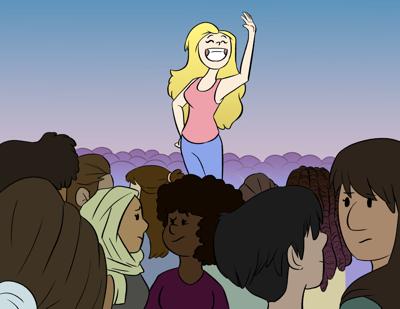
(Cindy Proaño / Daily Titan)
As another mediocre white man trends on Twitter with the caption “white boy of the month,” it has become more apparent that we have made white a synonym for attractive.
While beauty is in the eye of the beholder, there is no denying that the standards reward whiteness in the same way it rewards people for being conventionally good looking. This concept can even be traced back to colonialism, such as when the Spanish created the caste system to establish a racial hierarchy against people of color.
Through Western colonialism, the concept of beauty lying in white features has even found itself in South Korea, as double eye-lid surgery catapulted to popularity during the 1950s when American doctor David Ralph Millard was stationed in the country. It was there that he made it his life’s purpose to popularize the procedure in an attempt to westernize the population.
Now is the time to recognize that white privilege and pretty privilege do not occur in separate vacuums, but rather coexist in a larger cesspool of white supremacy.
Pretty privilege stems from being deemed physically attractive, resulting in better treatment and being perceived more positively than those considered unattractive.
White privilege is when white people have the unearned advantage of having more access to resources and power than people of color.
These privileges are not intended to undermine any struggles a white person may have but instead highlight the advantages they may have because of their skin color or their attractiveness.
It may seem that pretty privilege and white privilege are not necessarily related, but when the beauty standard praises and uplifts whiteness, it is nearly impossible to discuss without realizing its codependence.
The association between the two has proven unshakable even as the United States continues to grow in diversity. Most people still consider an “all-American beauty” a thin, white, blonde, blue-eyed woman and fail to recognize how many races and ethnicities call the states their home. Not to mention how the standard relies on the binary to sculpt these perfect people; this is simply erasure.
It is also important to note that even if a white person was not born with blonde hair or blue eyes, they still uphold that privilege because their race continues to be the standard. Oppression does not come with brown eyes and brown hair.
Unlike the public law the Spanish had enforced in everyday life, remnants of this kind of racism can be seen today on dating apps. In a 2014 blog post by Christian Rudder, the founder of OkCupid, data found that Black women and Asian men were the “least desirable” among other races and ethnicities.
It shows that people of color have to work much harder to get even an ounce of recognition as white people do. They have to be prettier, they have to be funnier, they have to go above and beyond to be on the same playing field, and even then, white people will still have the upper hand.
Although there have been many attempts to push back against these ideals, such as the body-positivity movement that aims to celebrate people whose age, weight and abilities combat typical beauty standards, it is better to ask why beauty is even a requirement for basic human decency in the first place.
Despite hundreds of years passing since Western colonization emerged, studies show that culture and media still play a large role in determining what is and is not visually appealing, regardless of how much we believe in the contrary. It is time that we question the origins of what we find beautiful.
To combat these sentiments, we need to dismantle centuries of oppression and, while it seems hard, we can start with not praising a white person for doing the bare minimum.






Commented
Sorry, there are no recent results for popular commented articles.